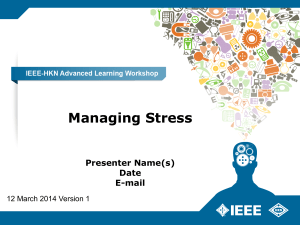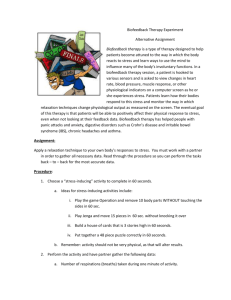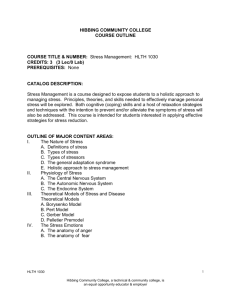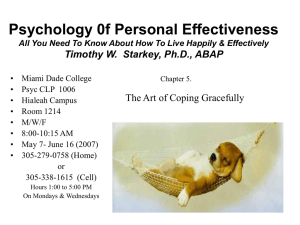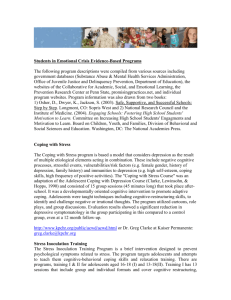Managing stress
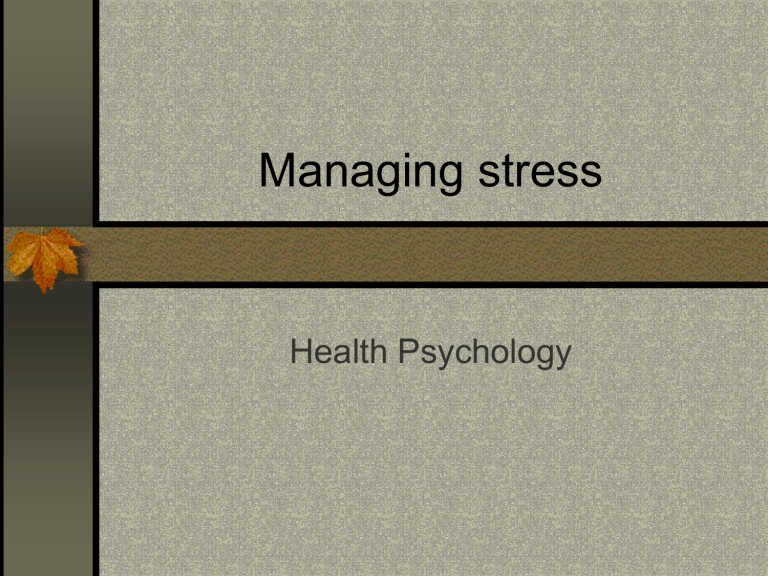
Managing stress
Health Psychology
Drugs
1.
Benzodiazepine; antianxiety drugs such as
Librium and Valium. Reduces the activity of the neurotransmitter serotonin. Inhibitory effect on the brain reducing muscle relaxation and a calming effect.
2.
Beta-blockers such as Inderal. Reduces activity in the sympathetic nervous system, effective against raised heart rate and blood pressure.
Problems
1.
Long-term use of benzodiazepines can lead to physical and psychological dependency, therefore should only be used for short periods.
2.
All drugs have side-effects. Benzodiazepines can cause drowsiness and adversely affect memory (Green 2000).
3.
Drugs treat the symptoms of stress not the causes. Most stresses are psychological, therefore physical measures do not address the real cause of the problem.
Defense Mechanisms
Freud
Defense mechanisms protect us from being consciously aware of a thought or feeling which we cannot tolerate. The defense only allows the unconscious thought or feeling to be expressed indirectly in a disguised form.
Let's say you are angry with a professor because he is very critical of you. Here's how the various defenses might hide and/or transform that anger:
Defence Mechanisms
Denial : You completely reject the thought or feeling.
"I'm not angry with him!"
Suppression : You are vaguely aware of the thought or feeling, but try to hide it.
"I'm going to try to be nice to him."
Defence Mechanisms
Reaction Formation : You turn the feeling into its opposite.
"I think he's really great!"
Projection : You think someone else has your thought or feeling.
"That professor hates me."
"That student hates the prof."
Defence Mechanisms
Displacement : You redirect your feelings to another target..
"I hate that secretary."
Rationalization : You come up with various explanations to justify the situation (while denying your feelings).
"He's so critical because he's trying to help us do our best."
Defence Mechanisms
Intellectualization : A type of rationalization, only more intellectualized.
"This situation reminds me of how Nietzsche said that anger is ontological despair."
Undoing : You try to reverse or undo your feeling by DOING something that indicates the opposite feeling. It may be an "apology" for the feeling you find unacceptable within yourself.
"I think I'll give that professor an apple."
Defence Mechanisms
Isolation of affect : You "think" the feeling but don't really feel it.
"I guess I'm angry with him, sort of."
Regression : You revert to an old, usually immature behavior to ventilate your feeling.
"Let's shoot spitballs at people!"
Defence Mechanisms
Sublimation : You redirect the feeling into a socially productive activity.
"I'm going to write a poem about anger."
Defence Mechanisms
Your Group's Role play: In your small group, develop a role play that you can peform in front of the class. In it demonstrate several defense mechanisms. Try to give everyone in the group a part to play. Good role plays usually spend a minute or so to develop the scene, the characters, and the situation at hand. At that point start to introduce the defenses into the scene. The whole role play should last about 3-5 minutes.
After you finish the scene, the class will try to guess which defense mechanisms you were demonstrating.
Coping Strategies
Problem-focused strategies
Confrontive coping - standing one's ground or expressing one's anger
Planful problem solving - having a plan of action or doubling effort
Emotion-focused strategies
I.
II.
III.
Distancing - making light of the situation, pretending nothing has happened, trying to forget about things
Self-controlling - keeping feelings to oneself, not letting others know how bad things are
Seeking social support - talked to somebody to find out more about the situation, asked a friend for advice
Emotion-focused strategies
IV.
V.
VI.
Accepting responsibility - self-criticism, saying to oneself that things will be better next time
Escape-avoidance - wishing the situation would go away, hoping for a miracle, trying to make oneself better by eating and drinking a lot.
Positive reappraisal - changing or growing up a better person, discovering what is important in life.
Problem-focused Vs emotion-focused
The method that works best, depends on the individual, but generally active strategies work better than avoidance strategies.
Conflicting evidence
Cairns and Wilson (1984) found the opposite in Northern Ireland. If stress is prolonged then it may be better to deny that there is much violence (in the case of Northern Ireland). People who denied the level of violence were less stressed than those that had a realistic appraisal of the situation.
Conflicting evidence
Wilson and Cairns (1992) found most people were using `distancing' as a coping strategy. This was not true of
Enniskillen, that had had a bomb aimed at civilians. here the coping strategy became one of positive reappraisal.
Problem-focused Vs emotion-focused
Suls and Fletcher (1985) pooled the results of a large number of studies in a meta--analysis to clarify the effects of avoidance and attention strategies. Their analysis led to two conclusions.
1.
Avoidance strategy can benefit coping mainly in the short run
2.
As time goes by, attention strategies become more effective than avoidance in the coping process
Problem-focused Vs emotion-focused
A 1-year study compared people who differed in their reported use of avoidance coping approaches. Of the subjects who experienced a high degree of stress during the intervening year, those who had reported a greater tendency to use avoidance methods had, at the end of the study, more psychosomatic symptoms-for example, headaches and acid stomach (Holahan and Moos, 1986).
Developing methods of coping
Young children are very poor at coping with stress. Middle-aged people tend to use more problem-focused forms of coping, whereas elderly people tend to use emotion-focused forms of coping. For example a middle-aged person might say "I stood my ground and fought for what I wanted", whereas an elderly individual might say "I went on as if nothing happened".
Developing methods of coping
The difference in coping strategies between middle-aged people and elderly people could be due to the different sorts of problems that they face. Middle-aged people experience stress from work and raising a family whereas elderly people may experience stress from home maintenance, for example.
Resources
I.
II.
III.
IV.
V.
Material - Enough money
Physical - health etc.
Intra-personal - self esteem etc.
Educational - knowledge about stress
Cultural - placing the stress in a wider context
Social support
1.
Esteem -intra-personal
2.
Informational -Educational
3.
Instrumental - Material
4.
Social Companionship - being with others
Social support
Although men tend to have larger social networks than women, women seem to use theirs more effectively for support.
Social support
People who report that they are coping well with stressful events in their lives are more likely to be regarded as attractive by others and less likely to be avoided than those who indicate that they are having some difficulties coping.
The implications of these results are depressing, because they suggest that those in greatest need for social support may be least likely to get it (Wortman &
Dunkel-Schetter, 1987).
Social support
Network size is related to social prestige, income, and education: the lower the prestige, income, and education level of individuals, the smaller their social networks tend to be.
Social support
Wexler - Morrison et al (1991) 133 women diagnosed as suffering from breast cancer. Major factor - social support, leads to longer survival.
Social support works for 2 reasons
I.
Encouragement to adopt healthy behaviours
II.
Buffering Model - Guard against and reverse the effects of stress.
Social support
Employers can help improve support systems on the job (Quick and Quick,
1984). They can do this in many ways, such as:
1.
2.
3.
Organising workers in teams or work groups
Providing facilities for recreation and fitness training during lunchtime or other non-work hours, arranging social events for workers and their families on weekends,
Providing counselling service to help employees through troubled times.
Social support
A supportive boss discusses decisions and problems with employees, compliments subordinates and gives them credit for good work, and stands behind reasonable decisions they make
(Kobasa,1986).
Social support
Social support can also be ineffective if the recipient interprets it as a sign of inadequacy, feels uncomfortable about being unable to reciprocated, or believes his or her personal control is limited by it (Cohen and McKay,
1984).
Social support
Being in a relationship reduces the number of complaints a person can suffer from. A study of German Women found that single women suffered the following complaints more often: Hiccups, Toothache,
Heartburn, Colds, Flatulence, Nausea,
Stomach-ache, and Headache. Whereas, women in relationships suffered more backache and insomnia!
Hardiness (Kobasa and
Maddi 1977)
The concept of 'hardiness' is taken to mean resistance to illness, or ability to deal with stress. From studies of highly stressed executives, Kobasa et al were able to identify the characteristics of those who handled stress well from those who did not.
Hardiness (Kobasa and
Maddi 1977)
Those who reported the fewest illnesses showed three kinds of hardiness.
1.
They showed an openness to change, i.e. life changes are seen as challenges to be overcome rather than threats or stressors.
2.
They had experienced a feeling of involvement or commitment to their job, and a sense of purpose in their activities.
3.
They experienced a sense of control over their lives, rather than seeing their life controlled by outside influences.
Hardiness (Kobasa and
Maddi 1977)
Kobasa found that the most important of these factors was the first, openness to change. Those who perceived change (such as the loss of a job) as a challenge rather than a devastatingly person event, were more likely to interpret the event positively and show fewer signs of stress.
Hardiness (Kobasa and
Maddi 1977)
Kobasa proposed three ways in which hardness could be improved.
I.
II.
Focusing.
People can be encouraged to focus on various body sensations in order to identify times of stress. This will help the person to consider what these sorts of stress might be.
Reconstructing stressful situations . This technique has the person think about a recent stressful situation and make two lists: ways it could have turned out better and ways it might have turned out worse. Doing this allows the person to examine alternative courses of action and realise that the situation could be worse.
Hardiness (Kobasa and
Maddi 1977)
III.
Compensating through self-improvement.
When people face a stressor they cannot avoid or change, it may be helpful for them to take on a new challenge they are likely to master. Doing so reassures them that they can still cope.
Hardiness at work
Employers can help by giving workers some degree of control over aspects of their jobs
(Quick and Quick, 1984). One approach involves having employees working in groups to make certain managerial decisions or solve problems, such as how to improve the quality of the product they manufacture. Other approaches include allowing workers to have some control over their work hours, which tasks to work on, and the order in which they do them.
Hardiness and the elderly
Elderly people in nursing homes and families can be allowed to do things for themselves and have responsibilities, such as in cleaning, cooking, and arranging social activities.
Evaluation of hardiness
I.
II.
The relative importance of the three aspects of 'hardiness (control,
Commitment and challenge) is uncertain, although it is likely that control is the most significant of these.
Kobasa's studies have tended to involve middle-class businessmen - results cannot reliably be generalized to other social and cultural groups.
Time Management
“Oh dear! Oh dear! I shall be too late!”
- The Rabbit in Lewis Carroll’s
Alice in Wonderland
Time is a man-made concept
We have become slaves to, rather than masters of time?
Time management
Time management skills are now taught to people to help them gain a sense of control over personal responsibilities.
Personality styles and behavior
the Type A person
the workaholic
the time juggler
Career
Children
Parents
Personal
Personality styles and behavior
the procrastinator
Career
the perfectionist
life-style trap
Children
Parents
Personal
Steps to initiate time management techniques
Prioritization
ABC rank order method
Pareto principle – 20% matters
Important vs. urgent method
Steps to initiate timemanagement techniques
Execution
assign specific deadlines
break large projects into small tasks
work on one section or task at a time
reward your accomplishments
Learn to delegate responsibilities
Schedule personal time each day
Additional time management ideas
Learn to schedule interruptions
Carry and use an idea book
Edit your life
Refine your
organization
skills
Additional time management ideas
Refine your
networking
skills
Bring balance back into your life
Time management
1.
Set goals.
2.
Make daily "to do" lists
3.
Set up a schedule for the day. The estimated time for each item on the list should be calculated, but if an urgent matter arises the list should be adjusted to include it.
Additional tips for studying
Physical Exercise and Stress
A sound mind in a sound body.
-
Juvenal
Physical exercise and stress
Physical exercise is a form of stress; the enactment of all the physiological systems that the fight-or-flight response triggers for physical survival.
Physical
Exercise and Stress
Physical exercise is a very effective means to reduce stress and a most natural means to express the manifestation of the stress response.
Physical Exercise
Anaerobic
without oxygen
short, intense, and powerful activity
aerobic
with oxygen
moderately intense activity for a prolonged period of time.
Physiological Effects of
Physical Exercise
decreased resting heart rate
decreased resting blood pressure
decreased muscle tension
better
quality sleep
increased resistance to colds and illness
increased tolerance of heat & cold
Physiological Effects of
Physical Exercise
decreased serum levels of cholesterol and triglycerides
decreased
percent of body fat
increased efficiency of heart muscle
decreased bone demineralization
decreased rate of aging
greater sense of overall well-being
Physical Exercise, Stress, and Balance
Physical exercise may be a stress to the body
but in moderate amounts,it tends to regulate (balance) the body’s physiological functions.
Homeostasis
is regained
through “ parasympathetic rebound .”
Newest Guidelines
Accumulate at least
30 minutes of moderate intensity physical activity at least 4, preferably all, days of the week.
From the US Surgeon General
Intensity by Perceived Exertion
Very, Very Light
Able to talk comfortably
Very Light
Fairly Light
Somewhat Hard
Hard
Very Hard
Very, Very Hard
10
11
12
13
6
7
8
9
14
15
16
17
18
19
20
Able to say some syllables
Phases of a Workout warm-up period
(5-10 minutes) stimulus period
(20-30 minutes) cool-down period
(5-10 minutes)
140
120
100
80
60
160
Phases of a workout
5 min..
20 min..
5 min..
training zone rest warm-up exercise cool-down recovery
Psychological Effects of
Physical Exercise
improved self-esteem
improved sense of self-reliance, self-efficacy
improved mental alertness, perception, and information processing
Psychological Effects of
Physical Exercise
increased perceptions of acceptance by others
decreased feelings of depression and anxiety
decreased overall sense of stress and tension
Steps to Initiate a
Fitness Training Program
start cautiously, progress moderately
pick an activity that you
really
enjoy
select a time of day to exercise
exercise using the right clothes and equipment
Steps to Initiate a
Fitness Training Program
for motivation, workout with friends
set personal fitness goals for yourself
take precautions, avoid injuries
Physical exercise
Most studies use correlational or retrospective methods, and show that people who exercise or are physically fit often reported less anxiety, depression, and tension in their lives than do people who do not exercise or are less fit
(Blumenthalof & McCubbin, 1987).
Unfortunately, causality cannot be established with such techniques.
Physical exercise
Jennings S. L. (1986) conducted an experiment with healthy 19 to 27-yearold individuals who had sedentary occupations and had not regularly engaged in vigorous physical activity in the previous year.
Physical exercise
Over the next four months, the subjects spent one month at each of four levels of activity:
1.
Their sedentary normal activity
2.
Below normal activity, which included two weeks of rest in a hospital setting
3.
Above normal activity, which included three sessions of vigorous exercise weekly
4.
Much above normal activity, consisting of their normal activity plus daily vigorous exercise.
Physical exercise
Each exercise period lasted 40 minutes.
Measurements of heart rate and BP were taken after each month. The results demonstrated that regular exercise lowers heart rate and both systolic and diastolic blood pressure.
Preparing for stressful events
Parents can help prepare a child for starting day care by taking the child there in advance to see the place, meet the teacher, and play for a while
(Sarafino, 1986).
Preparing for stressful events
Janis (1958) studied the need for people to prepare for stressful life events, such as surgery. He found those patients with moderate levels of anxiety before the surgery showed better adjustments after the operation compared with those with very high or very low anxiety. Janis proposed that some degree of anticipatory worry about a stressful event is adaptive because it motivates coping via the process he called the "work of worrying".
Preparing for stressful events
There are three steps in this process:
1.
The person first receives information about the event, which generates anxiety
2.
Expectations are developed by rehearsing the event mentally
3.
Coping techniques are mobilised in an effort to become reassured of a successful outcome.
Preparing for stressful events
Subsequent research has confirmed that Janis may be correct about high levels of anxiety impairing the patient's success in coping with or recovery from surgery. There is no evidence to support the view that low levels of anxiety could impair recovery, in fact the opposite has been found (Anderson & Masur, 1983).
Preparing for stressful events
Other ways of improving people's preparedness for stressful events is by using psychotherapy, in which patient's express their worries and receive emotional support. Another method would be hypnosis , but much would depend upon the person's ease of suggestibility.
Preparing for stressful events
Another method would be enhancing the patient's feelings of control.
Patients can be taught behavioural control by teaching them how to reduce discomfort or promote rehabilitation through specific actions, such as by doing exercises to improve strength or deep breathing exercises to reduce pain.
Preparing for stressful events
Another method enhances cognitive control, by instructing people on ways to concentrate on the pleasant or beneficial aspects of the surgery.
Another method would use informational control, in which patients received information about the procedures and/or sensations they will experience.
Preparing for stressful events
Care has to be taken over how much information one should give when trying to provide informational control. Los
Angeles City Council placed cards in the city lifts assuring passengers that they should stay calm, since "there is little danger of the car dropping uncontrollably or running out of air".
Preparing for stressful events
The Council had to remove the cards in the end because many passengers were becoming anxious after reading the message; they had not thought about the dangers until they saw the cards! (Suzanne Thompson, 1981).
Preparing for stressful events
Young children become more anxious if given too much information about medical procedures (Miller and green,
1984).
Progressive Muscular
Relaxation
Relaxation is the direct negative of nervous excitement. It is the absence of nerve-muscle impulse.
- Edmund Jacobson,
M.D.
Progressive Muscular
Relaxation
Muscles respond
to thoughts of perceived threats
with tension or contraction
Muscular tension
the most common symptom of stress
can lead to:
stiffness, pain, discomfort, distorted and disaligned posture and joint stability
Progressive Muscular
Relaxation
Muscles can contract in one of three ways:
concentrically (shortening)
eccentrically (lengthening)
isometrically
(no visible change in length)
Progressive Muscular
Relaxation
Muscle tension
produced through the
stress response
primarily
isometric
Over time, muscles
contracted isometrically
begin to show signs of
shortening
Progressive Muscular
Relaxation
Systematic
approach to relieving muscle tension
Edmund Jacobson
a simple technique used to promote rest and relaxation
by systematically tensing and relaxing the body’s musculature, from feet to the head
Benefits of PMR
Decreased levels of muscle tension
Increased awareness of muscle tension
Reduced muscle tension
& deepened sense of relaxation
Steps of Initiate PMR
Comfortable position
Monitoring your breathing
Inhale when you contract each muscle group
Exhale when you relax each muscle group
Focus your concentration on each muscle group as you work regions of your body
Typical phase for each muscle group using PMR
First contraction: 100% @ 5-10 seconds
release and relax (exhale) compare relaxation to contraction
Second contraction: 50% @ 5-10 seconds
release and relax (exhale) compare relaxation to contraction
Third contraction: 5-10% @ 5-10 seconds
release and relax (exhale) compare relaxation to contraction
Progressive Muscular
Relaxation
Research, specifically biofeedback using electromyography, proves that
this technique reduces muscular tension
.
Evaluation
It is fairly easy to practice relaxation, even in unusual situations. These techniques may also involve cognitive strategies that help reduce arousal in unpleasantly arousing circumstances. Although relaxation techniques can be useful by reducing the levels of stress response, the action is nonspecific. Effective long-term stress reduction requires focused intervention on the source of the stress.
Biofeedback
Biofeedback is a technique in which an electromechanical device monitors the status of a persons physiological processes, such as heart rate, blood pressure or muscle tension, and immediately reports that information back to the individual. The person is able to then gain voluntary control over these processes through operant conditioning. The feedback from the device becomes the reinforcement.
Biofeedback
An experiment was conducted with patients suffering from chronic muscle-contraction headaches (Budzynski et al., 1973). Those who were given biofeedback regarding muscle tension in the forehead later showed less tension in those muscles and reported having fewer headaches than subjects in control groups. These benefits were found at a follow-up session after three months.
Biofeedback seems to be as effective as progressive muscle relaxation methods for treating headache (Blanchard and Andrasik,
1985).
Limitations of biofeedback techniques
It is claimed that biofeedback techniques can have significant positive effects in the reduction of generalised anxiety disorders.
The use of this technique and the related efforts to reduce heart rate in sufferers of anxiety disorders has had only limited success.
Biofeedback may be no more effective than muscle relaxation in the absence of biofeedback. This is a critical issue as biofeedback can be expensive as a technique.
Biofeedback
Virginia Attanasio, et al. (1985) gave three reasons why biofeedback is particularly suitable for use with children :
1.
Children treat biofeedback as a game, and are therefore interested and motivated in the procedure.
2.
Children are less sceptical about their ability to succeed in biofeedback training.
3.
Children are more likely to practise their training at home, as they are instructed to do.
Biofeedback
The problems with using biofeedback with children are:
1.
Children have shorter attention spans, particularly when below the age of 8.
2.
Children may perform disruptive behaviours such as disturbing the electrodes or by interrupting by talking about tangential topics.
Modelling
Children watched a short film showing a five-year-old boy's reactions to figures of the cartoon characters Mickey
Mouse and Donald duck (Venn and Short, 1973). In the film, when the boy's mother showed him the Mickey Mouse figure he screamed and withdrew; but when she showed him the
Donald duck figure he remained calm and displayed no distress.
Modelling
While the subjects watched the film physiological measures of stress were taken, confirming that the children were more aroused while watching the episode with
Mickey Mouse (fearful) than while watching the one with Donald duck. After the film they tended to avoid a Mickey Mouse figure (the stressful one) in favour of Donald duck. The effect only lasted for one or two days.
Modelling
Modelling is useful in reversing this learning and in helping people to cope with stressors. The procedure is rather like desensitisation: the person relaxes while watching a model calmly perform a series of activities arranged as a stimulus hierarchy. The stimulus can be presented using films or video tapes, or by using real life models and events.
Modelling
Barbara Melamed et al., 1983, found that by showing children video tapes she was able to reduce the stress of being in hospital and improve their recovery from surgery. However, children under the age of 8 who had had previous surgery experienced increased anxiety!
Post-traumatic Stress
Disorder
I.
II.
III.
IV.
V.
VI.
Behavioural treatments
Cognitive treatments
Psychotherapeutic approaches
Group methods
Bereavement counselling
Grief therapy
Main treatment
This method is based on the view that fears are learned by classical conditioning. Desensitisation is a classical conditioning procedure that reverses this learning by pairing the feared object or situation with either pleasant or neutral events. The method uses a stimulus hierarchy.
Main treatment
The patient is given the opportunity to get used to something that is similar to their fear, for example in order to overcome a fear of dentists the patient might be asked to imagine waiting with a friend, who is to have treatment, in the dentists waiting room.
Main treatment
After the patient gets used to this idea they can be introduced to something a little more like the real situation. After a series of 10 to 15 steps the patient might be able to imagine having their tooth extracted. As an exercise think of a phobia and plan a series of steps that could be used in applying the systematic desensitisation technique.
systematic desensitisation
In one study with dental-phobic adults who simply imagined each step in a hierarchy, the procedure successfully reduced their fear in six one and a half hour sessions (Gatchel, 1980).
Sessions with children tend to be shorter because of their short attention span.
Cognitive restructuring and
Rational Emotive Therapy
Cognitive restructuring - developed by
Arnold Lazarus (1971). Faulty, irrational thinking. These irrational thoughts are replaced by more constructive or realistic ones.
Rational-emotive therapy (RET) is based on cognitive restructuring and was developed by Albert Ellis (1962).
Cognitive restructuring and
Rational Emotive Therapy
Commonly used irrational ways of thinking include:
awfulizing -for example, "it is awful if I get turned down when I ask for a date."
Can't-stand-itis -"I can't stand not doing well on a test"
Musterbating -"people must like me, or I'm worthless."
ABCDE framework for rational emotive therapy
RET involves patients reading materials about irrational believes or doing desensitisation exercises. RET has been found to be successful in treating anxiety and depression (DiGiuseppe &
Miller, 1977).
Activating -experience that creates the stress. For example being fired from a job.
ABCDE framework for rational emotive therapy
Beliefs - and thoughts that are a response to the stress. A rational response might be "I must do better next time". An irrational response might be " I can't do any thing right, I am totally worthless and useless. I can't stand myself and I can't bear facing people and telling them that I was fired."
ABCDE framework for rational emotive therapy
Consequences - positive or negative coping behaviours. For example, the above irrational belief could lead to a person not bothering to seek another job.
ABCDE framework for rational emotive therapy
Disputing - the patients learns to differentiate between irrational and rational thoughts, and then learns to dispute the irrational thoughts, such as
"I am a loser".
Effect - of the therapy. For example, seeking and successfully securing a new job.
ABCDE framework for rational emotive therapy
We are not sure whether there are any long term effects of RET.
Stress - inoculation
(Meichenbaum)
Preparing people for stress. Just like an injection to prevent a disease.
Michenbaum and Cameron (1983)
Stress - inoculation
(Meichenbaum)
Conceptualisation - identify and express feelings and fears.
Educated about stress. The client is encouraged to relive stressful situations, analysing what was stressful about them and how they attempted to deal with them.
Stress - inoculation
(Meichenbaum)
Skill acquisition and rehearsal
For example, how to relax, desensitisation, emotional discharge, turning to others and cognitive redefinition. specific skills might be taught, such as, parenting techniques, communication skills, time management or study skills.
Stress - inoculation
(Meichenbaum)
Application and follow through.
The trainer guides the patient through progressively more threatening situations so that the patient can apply their newly acquired skills. The techniques become reinforced and this makes the practises self sustaining.
Stress - inoculation
(Meichenbaum)
Zeigler et al (1982) found cross-country runners found stress inoculation useful in reducing stress and in improving running performance.
Evaluation of
Meichenbaum's stressinoculation training
Meichenbaum's model focuses on both the nature of the stress problem
(enabling clients to more realistically appraise their life) and the ways of coping with stress giving clients more understanding of the strengths and limitations of specific techniques).
Evaluation of
Meichenbaum's stressinoculation training
The combination of cognitive strategies and behavioural techniques makes stress-inoculation a potentially effective way of managing stress. Despite this potential, few controlled studies have confirmed its predictions.
Evaluation of
Meichenbaum's stressinoculation training
Stress inoculation has been effective in a variety of stressful situations, ranging from anxiety about mathematics in college students, managing hypertension in all age groups and stress management in general. It has been successfully combined with other treatment methods to alleviate stress.
Evaluation of
Meichenbaum's stressinoculation training
For example, Kiselica et al. (1994) used a combination of stress inoculation, progressive muscle relaxation, cognitive restructuring and assertiveness training to significantly reduce trait anxiety and stress related symptoms among adolescents.
Evaluation of
Meichenbaum's stressinoculation training
These results however, did not extended to their improving academic performance, suggesting that other factors may also be involved here.
Interventions cannot necessarily rule out the possibility of placebo or expectancy effects.
Meditation
When the pupil is ready, the teacher will come.
Ancient Chinese Proverb
Meditation
In simple terms, meditation is a
mind-cleansing
or emptying process
At a deeper level, meditation is
focused concentration
and increased awareness of one’s being
Meditation
When the mind is emptied of conscious thought
unconscious thoughts
can enter the conscious realm
to bring
enlightenment
to our lives
Types of meditation
Exclusive or restrictive meditation concentration awareness inner peace
Inclusive or opening-up meditation concentration awareness inner peace
Vehicles for Exclusive
Meditation
mental
repetition (mantra)
visual concentration (tratek)
repeated sounds (nadem)
physical
repetition (breathing, rhythmic exercise)
tactile
repetition (beads, shell, stone etc.)
Examples of exclusive meditation
Transcendental Meditation
(TM)
The Relaxation Response
Inclusive Meditation
Observance with emotional detachment
Examples include:
Zen
Meditation
Mindfulness
Mediation
divine enlightenment
Zen
Meditation
Split-Brain Theory
left-brain
hemisphere
left-brain functions
right-brain
hemisphere
right-brain functions
meditation can lead to
an altered state of consciousness
associated with right-brain functions
Altered States of Consciousness
Characteristics
time distortion
ineffability
present centredness
perception distortion
enhanced receptivity
self -transcendence
Physiological Effects of
Meditation
decreased oxygen consumption
decreased blood lactate levels
increased skin resistance
decreased heart rate
decreased blood pressure
decreased muscle tension
increased alpha waves
Meditation
Transcendental meditation is a method in the practice of yoga that was promoted by Maharishi Mahesh Yogi.
The method is a way of improving physical and mental health and reducing stress (Benson, 1984).
Meditation
People using this procedure are instructed to practise it twice a day, sitting upright but comfortably relaxed with eyes closed, and mentally repeating a word or sound (such as
"om"), called a mantra. The mantra is to prevent thoughts from occurring.
Meditation
Reviews of studies into the effectiveness of transcendental meditation have found that the levels of rest produced are not that profound.
There are no consistent differences in blood pressure, heart rate, or respiration rate between the meditating and resting control subjects (Holmes, 1984).
Meditation
However Buddhist monks in South-East
Asia can dramatically alter their bodies metabolism and their brains electrical activity through meditation (Benson et al., 1990).
Meditation
Evaluation
– Meditation has the advantage of portability and may give individuals more confidence to deal with stressful situations (Green 2000).
– As with relaxation techniques, the action of meditation techniques is none specific rather than focused on effective intervention at source.
Hypnosis
Hypnosis is considered to be an altered state of consciousness that is induced by special techniques of suggestion and leads to varying degrees of responsiveness to directions for changes in perception, memory, and behaviour (Orne, 1989).
Hypnosis
Only 15 to 30% of the population is easily and deeply hypnotisable (Evans,
1987). Children between the ages of seven and 14 are the most suggestible
(Hilgard, 1967). People can learn to hypnotise themselves, this is called self-hypnosis .
Hypnosis
There are two problems with doing therapy and research with hypnosis:
– most people are not highly suggestible
– the success of the treatment depends heavily on how suggestible the subjects are.
Hypnosis
However, studies have found that hypnosis can be helpful in stress management, but it is not necessarily a more effective method than other relaxation techniques (Tapp, 1985).
Using stress management to reduce coronary risk
Modifying type A behaviour
Ethel Ruskin et al. (1978) began a research and therapy programme in the
1970s to modify type A behaviour. The patients studied were type A male subjects who were healthy and employed in professional or managerial positions.
Using stress management to reduce coronary risk
The subjects were assessed for type A behaviour with the structured interview method and given a physical examination. The healthy type a men were randomly assigned to two therapy groups:
– progressive muscle relaxation
– brief psychotherapy, in which a therapist discussed with the men how their childhood experiences may have led to their competitive, hard driving behaviour.
Using stress management to reduce coronary risk
A third group was formed from type A individuals who showed signs of chronic heart disease; these men received the progressive muscle relaxation therapy.
Each group had weekly therapy sessions over 14 weeks, during which time the subjects were asked to maintain their usual habits.
Using stress management to reduce coronary risk
Psychological and physiological measures taken before, immediately after and six months after the treatment phase began. All three groups improved with respect to their feelings of time pressure, blood cholesterol levels, and
BP. Six-months later, the two relaxation groups maintained their improvements better than the psychotherapy group did.
Using stress management to reduce coronary risk
Psychological and physiological measures taken before, immediately after and six months after the treatment phase began. All three groups improved with respect to their feelings of time pressure, blood cholesterol levels, and
BP. Six-months later, the two relaxation groups maintained their improvements better than the psychotherapy group did.
Using stress management to reduce coronary risk
The programme was revised by using a multimodal approach (Roskies, 1983).
The revised programme included progressive muscle relaxation and most aspects of RET and stress inoculation training.
Using stress management to reduce coronary risk
The multimodal approach was used to control the individuals physical tension through relaxation, emotional outbursts through RET, and interpersonal friction through stress inoculation training in problem-solving and communication skills.
Using stress management to reduce coronary risk
This revised programme was tested in a study with men who were employed in managerial jobs, had passed a physical examination, and exhibited the type A pattern in the structured interview
(Roskies et al., 1986). They were randomly assigned to either the revised multimodal programme or to one of two physical exercise groups (aerobic training or weight training).
Using stress management to reduce coronary risk
All subjects attended two or three sessions a week for ten weeks. The men were tested at the end of the training period using the structured interview, and their blood pressure and heart rate reactivity were assessed in response to stressors, such as doing mental arithmetic.
Using stress management to reduce coronary risk
None of the three treatments reduced the men's physiological reactivity, but the multimodal programme was more successful than either of the exercise programmes in reducing the three components of type a behaviour.
Using stress management to reduce coronary risk
The programme was revised by using a multimodal approach (Roskies, 1983).
The revised programme included progressive muscle relaxation and most aspects of RET and stress inoculation training.
Using stress management to reduce coronary risk
The multimodal approach was used to control the individuals physical tension through relaxation, emotional outbursts through RET, and interpersonal friction through stress inoculation training in problem-solving and communication skills.
Using stress management to reduce coronary risk
This revised programme was tested in a study with men who were employed in managerial jobs, had passed a physical examination, and exhibited the type A pattern in the structured interview
(Roskies et al., 1986). They were randomly assigned to either the revised multimodal programme or to one of two physical exercise groups (aerobic training or weight training).
Using stress management to reduce coronary risk
All subjects attended two or three sessions a week for ten weeks. The men were tested at the end of the training period using the structured interview, and their blood pressure and heart rate reactivity were assessed in response to stressors, such as doing mental arithmetic.
Using stress management to reduce coronary risk
None of the three treatments reduced the men's physiological reactivity, but the multimodal programme was more successful than either of the exercise programmes in reducing the three components of type a behaviour.
Raymond Novaco (1975)
Raymond Novaco (1975) has demonstrated the usefulness of stress inoculation training and relaxation in helping people to control the anger. He trained patients who were both self identified and clinically assessed as having serious problems controlling anger.
Raymond Novaco (1975)
The subjects learnt about the role of arousal and cognitive processes in feelings of anger. Then they learned muscle relaxation along with statements, for example:
Raymond Novaco (1975)
Preparing for a provocation
This could be a rough situation; I have the know-how to deal with it. I can work out a plan to handle this. Easy does it.
Remember, stick to the issues and don't take it personally. There won't be any need for an argument. I know what to do.
Raymond Novaco (1975)
Impact and confrontation
As long as I keep my cool, then I am in control of the situation. You don't need to prove yourself. Don't make more out of this than you have to. There is no point in getting mad. Think of what I have to do, look for the positives and don't jump to conclusions.
Raymond Novaco (1975)
Coping with arousal
Muscles are getting tight. Relax and slow things down. Time to take a deep breath.
Let's take the issue point by point. My anger is a signal of what I need to do. Time for problem-solving. He probably wants me to get angry, but I'm going to deal with it constructively.
Raymond Novaco (1975)
Subsequent reflection
Conflict unresolved
Forget about the aggravation. Thinking about it only makes you upset. Try to shake it off. Don't let it interfere with your job.
Remember relaxation. It is a lot better than anger is. Don't take it personally. It's probably not so serious.
Raymond Novaco (1975)
Subsequent reflection
Conflict resolved
I handled that one pretty well. That's doing a good job. I could have got more upset than it was worth. My pride can get me into trouble, but I'm doing better at this all the time. I actually got through that without getting angry.
Raymond Novaco (1975)
The subjects practiced the techniques while imagining and role playing realistic anger situations arranged in a hierarchy from least to most provoking. The subjects were able to control their anger as measured by self reports and their blood pressure when provoked in the laboratory.
The end


